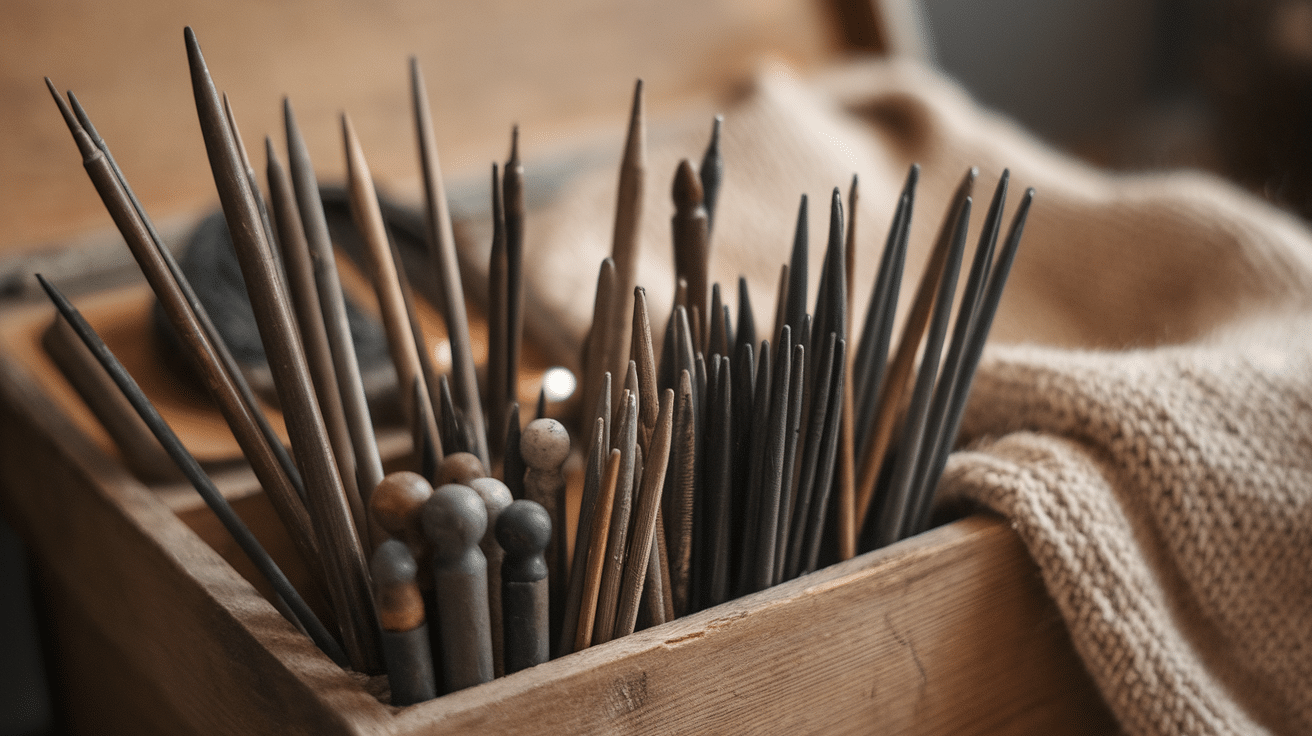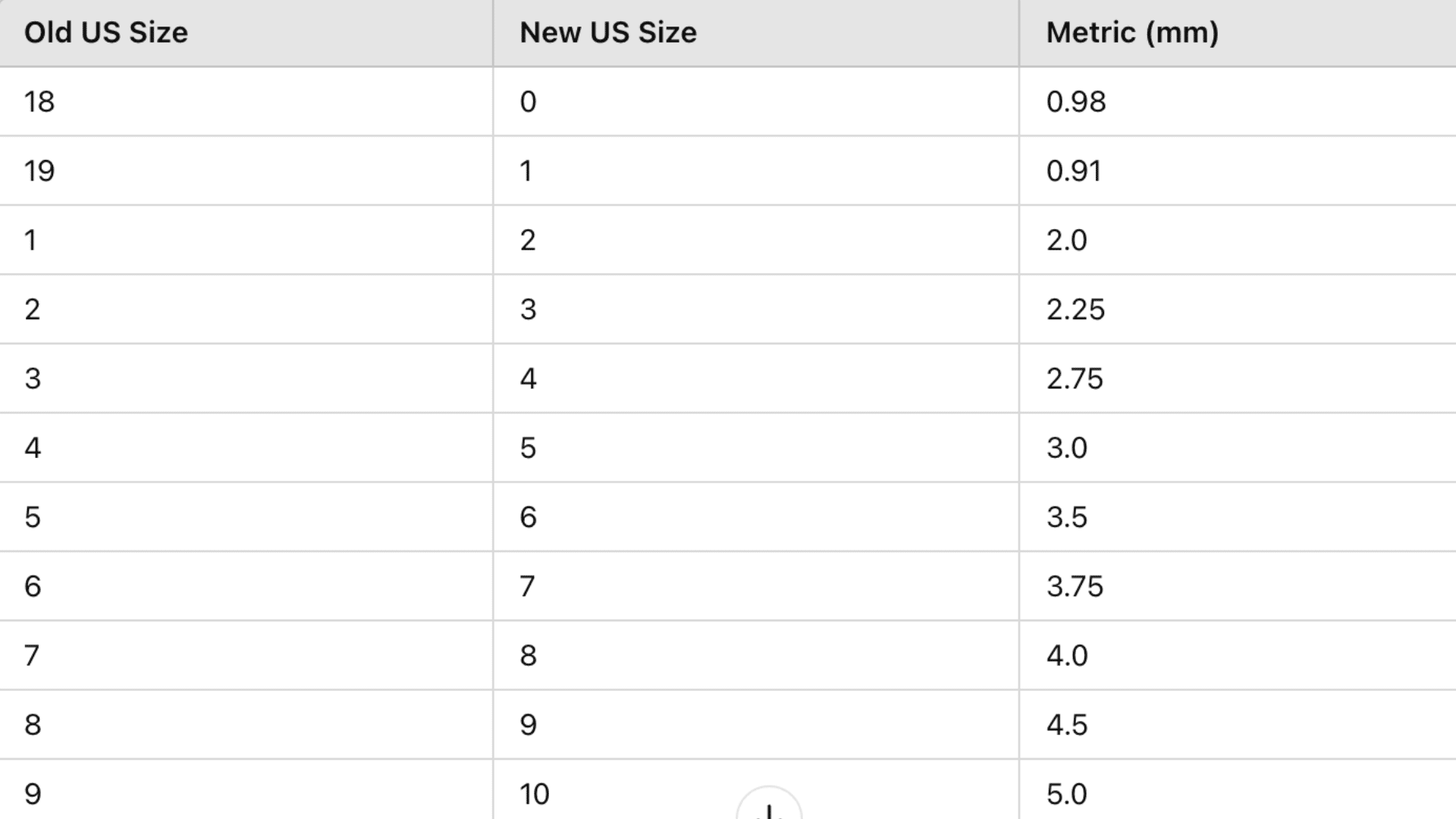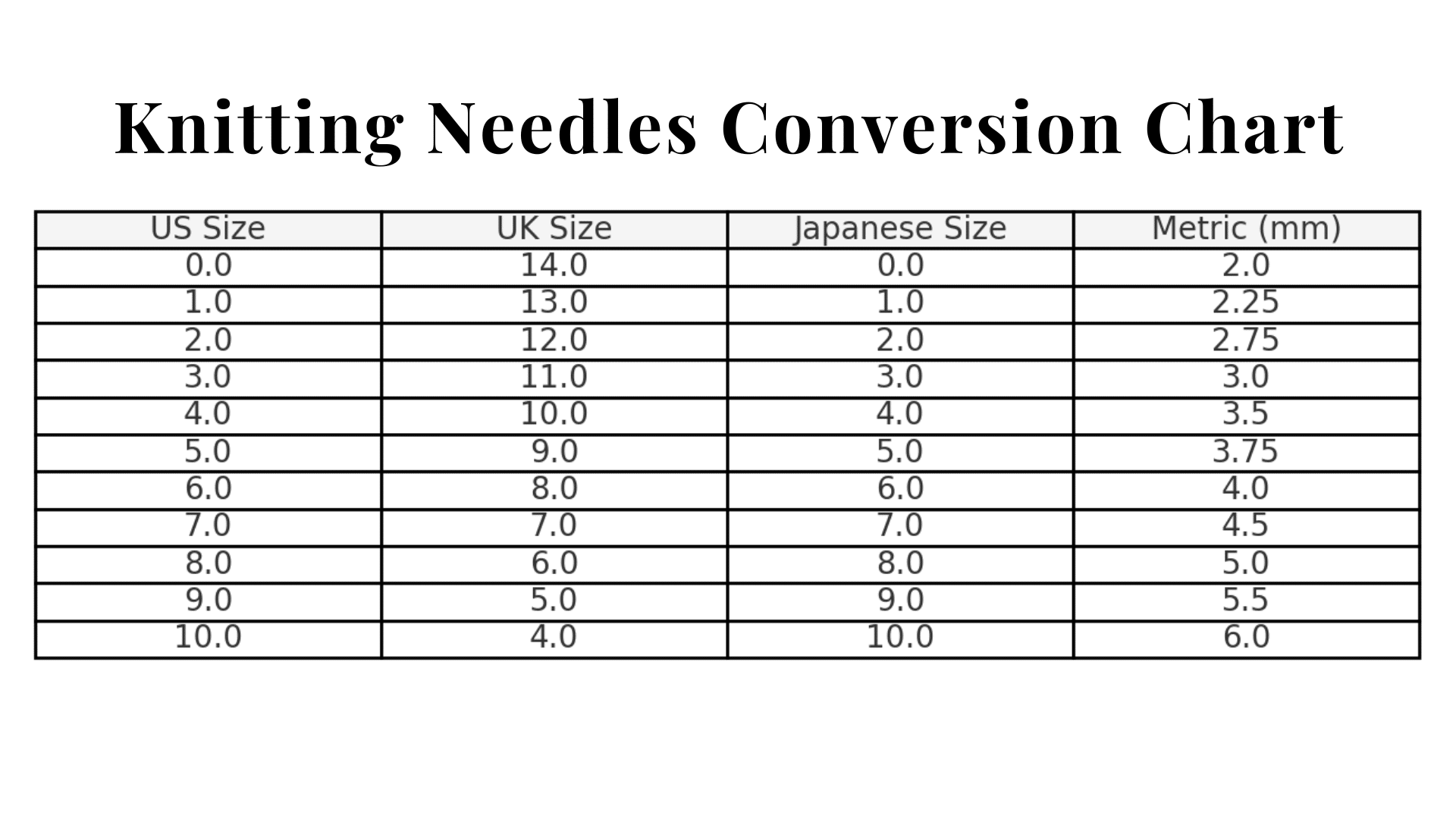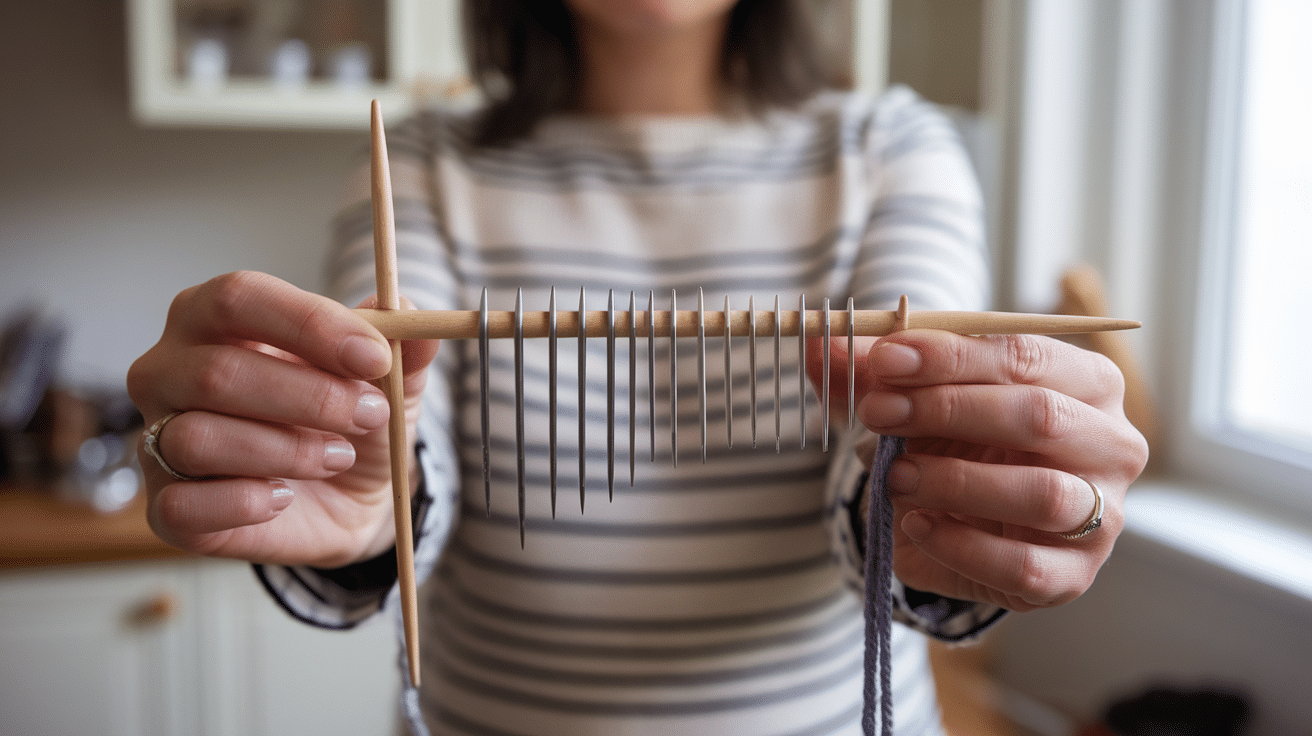Knitting needle sizes are important for any knitting project. Over time, how we measure and label needles has changed, which can sometimes make it confusing when using older patterns or trying to match up new ones.
Understanding the difference between old and new knitting needle sizes can help you choose the right needles for your projects and ensure that your pieces turn out the way you want them to.
In this blog, I’ll talk about the history of knitting needle sizes, how modern sizing systems came to be, and how you can easily switch between different sizing methods.
If you’re using needles from your grandmother’s knitting kit or new ones from the craft store, knowing how to work with different needle sizes will help you become a more confident knitter.
The History of Knitting Needle Sizing

The history of knitting needle sizes starts with a simple but important concept: how do you measure a knitting needle? The way we size needles today may seem like common knowledge, but it hasn’t always been so clear. In the past, sizing was based on the thickness of the wire used to make the needle, which led to some confusion.
Knitting needles were originally sized based on the wire thickness used to make them. The standard wire gauge system measured the diameter of the needle. The thinner the wire, the larger the number, and the thicker the wire, the smaller the number.
For example, an old US size 18 needle (the thickest) was smaller in number than a size 0 needle (which was much thinner). This sizing method was logical then, but it didn’t make sense for knitters who were just getting started or using needles from different manufacturers.
As knitting became more popular, especially in the 20th century, the need for a more standardized system grew. The old system confused people, especially since needle manufacturers often had slightly different interpretations of what a “size 1” or “size 10” meant.
Modern Knitting Needle Sizes
The most common systems used today are based on a combination of numbers and measurements.
Metric System Adoption
The metric system is the most widely used standard today for knitting needle sizes. The measurement is based on the needle’s diameter in millimeters (mm).
For example, a size 4 needle measures 3.5 mm in diameter. The metric system is used worldwide, clearly and consistently measuring needles across different countries and brands.
In addition to the metric system, needle sizes are also often given a corresponding number. This system still uses numbers but also provides the millimeter measurement next to the number. For example, a US size 8 is often listed as 5 mm.
Understanding how the modern knitting needle size system works will help you choose the right needles for your projects. Knowing the number and the corresponding millimeter size is essential for getting the right fit for your yarn and project.
Comparing Old and New US Knitting Needle Sizes

As knitting has evolved, so have the needle sizes. The old US system was quite different from the one used today, and it can be confusing to figure out what size needle you need, especially if you’re using vintage patterns.
1. Old US System
In the old US system, the needle size was inversely related to its thickness. In other words, the larger the needle, the smaller the number. For example, an old US size 18 needle was larger than a US size 1 needle.
This system caused a lot of confusion because knitters weren’t sure if the number they saw was a smaller or larger needle. An old size 19 (0.91 mm) needle is smaller than an old size 18 (0.98 mm) needle, which is the opposite of how we expect it to be now.
2. New US System
The new system, which is still used today, makes more sense. The higher the number, the larger the needle. So, a size 1 is thinner than a size 10.
For example, a size 0 (2 mm) needle is smaller than a size 1 (2.25 mm) needle. The new system has made it easier for knitters to understand the size they need for different types of projects.
Understanding the difference between old and new US needle sizes can help avoid confusion when reading patterns from different eras. The new system is far more straightforward to understand, especially for beginners.
Comparison of Knitting Needle Sizes Across Systems
When knitting, it’s important to understand that needle sizes can vary depending on the system used, whether it’s US, UK, or Japanese. Knowing how to compare and convert between these systems will help you choose the right needles for your projects, especially when patterns come from different regions.
1. US Needle Size System
In the US, knitting needle sizes are typically measured with numbers. These numbers can sometimes be confusing, as larger numbers indicate smaller needles in the older system, while in the modern system, larger numbers indicate larger needles.
2. UK Needle Size System
The UK system is somewhat similar to the old US system in that larger numbers correspond to smaller needles. This can make it tricky for knitters to switch between UK and US patterns. The UK system can be confusing, but there are charts available to help you convert between UK sizes and US sizes. For example, a UK size 10 equals a US size 3.
3. Japanese Needle Size System
Japan uses a completely different system for needle sizes. They measure the needles based on the diameter in millimeters, which is similar to the modern metric system. You can often rely on the millimeter measurements when converting between Japanese needle sizes and US or UK sizes.
4. Metric Needle Size System
The metric system is the most straightforward system used worldwide. It is based purely on the diameter of the needle in millimeters (mm), making it easier to understand and convert across different countries. The metric system is especially useful because the size number directly correlates to the needle diameter.
Understanding knitting needle sizes across different systems can seem complicated, but it’s easy to navigate with the right knowledge. Whether you’re using US, UK, Japanese, or metric sizes, knowing the equivalent sizes will help you make sure you’re using the right needles for your projects.
Guide to Converting Needle Sizes
When working with knitting patterns from different countries or eras, it’s important to know how to convert needle sizes. Thankfully, conversion charts and tools make this process easier.
1. Using Conversion Charts

A good conversion chart can help you easily match the needle size in the pattern with the size you need. You can find these charts online or in knitting books. Match the size number from one system to its equivalent in another. For example, a US size 8 equals a 5 mm needle in the metric system.
2. Utilizing a Needle Gauge

A needle gauge is a handy tool for measuring the diameter of your needle. This can help you figure out the exact size of any needle, old or new. Insert the needle into the gauge to see which hole it fits into, and you’ll immediately know the right size.
Converting knitting needle sizes doesn’t have to be difficult if you have the right tools and charts. With a bit of knowledge and the right tools, you can confidently knit with any pattern, regardless of its origin.
Picking the Right Knitting Needle Sizes
Choosing the right knitting needle size is crucial for the success of your project. The size of your needles can affect the fabric’s texture, drape, and overall fit of your finished piece. Whether you’re a beginner or an experienced knitter, these helpful tips will guide you in selecting the right needle size and ensuring a smooth knitting experience.
1. Check the Pattern’s Recommended Needle Size
- Always Follow the Pattern: Most knitting patterns will specify a needle size. If the pattern recommends a particular needle size, starting with that size is best to achieve the correct gauge.
- Consider the Yarn: Patterns often suggest a needle size based on the yarn weight. For example, a pattern using worsted weight yarn usually recommends size 7-9 needles. Make sure you match the needle size to the yarn.
2. Understand Gauge and Tension
- Check Your Gauge: Gauge is the number of stitches and rows per inch in a knitted swatch. It is important to knit a small swatch before starting your project to check your gauge.
- Adjust Needle Size to Match Gauge: If your gauge is too small (fewer stitches per inch), use a larger needle. If your gauge is too large (more stitches per inch), use a smaller needle.
3. Consider the Yarn Weight
Match the needle to the yarn weight. Yarn weights and recommended needle sizes often go hand in hand. Here are some general guidelines:
- Lace Weight: US 000-1 (1.5-2.25 mm)
- Fingering Weight: US 1-3 (2.25-3.25 mm)
- Sport Weight: US 3-5 (3.25-3.75 mm)
- Worsted Weight: US 7-9 (4.5-5.5 mm)
- Bulky Weight: US 10-13 (6-9 mm)
4. Needles for Different Projects
- Socks: You typically want smaller needles for a tighter, more durable fabric for knitting socks. You may want to use US 1-2 (2.25-2.75 mm) needles with sock-weight yarn.
- Blankets and Shawls: Larger needles, such as US 9-10 (5.5-6 mm), are often used for larger projects like blankets or shawls, where a looser, drapey fabric is desired.
- Garments: The needle size for knitted garments, like sweaters, depends on the desired fit. A smaller needle may be used for a firmer, more structured fit, while a larger needle is used for a looser look.
5. Circular Needles vs. Straight Needles
- Circular Needles: Circular needles are versatile and can be used for flat or round projects. They allow you to knit large pieces without worrying about running out of space on the needle, and they help distribute the yarn weight.
- Straight Needles: Straight needles are best for flat projects, like scarves, shawls, or simple garments. They’re less versatile than circular needles but can be more comfortable for smaller, straightforward projects.
Choosing the right knitting needle size is an important part of any knitting project. Whether you’re following a pattern or working with a specific yarn, understanding how needle size affects your fabric’s texture, drape, and fit will help you create beautiful pieces every time.
Conclusion
Understanding knitting needle sizes, both old and new, is an essential skill for knitters of all levels. Whether you’re using vintage needles or modern ones, knowing how to convert between different sizing systems can save you time and frustration.
The more familiar you are with the various systems—US, UK, Japanese, and metric—the easier it will be to tackle any knitting project, old or new. Knitting is all about creativity, so don’t let needle sizing hold you back.
Keep a conversion chart handy, and soon, you’ll knit confidently, no matter which pattern or needle system you’re working with.
Frequently Asked Questions
How do needle sizes affect my knitting project?
Needle size affects the fabric’s texture and fit. Larger needles create looser, airier fabric, while smaller needles result in a tighter, denser texture. Needle size also impacts the overall size of the project.
Are there different needle sizes for different yarn types?
Yes, different yarn weights require different needle sizes. For example, lace weight yarn typically needs smaller needles, while bulky yarn works better with larger needles.
Can I mix needle sizes within a project?
While it’s possible to use different needle sizes for specific parts of a project (e.g., using smaller needles for ribbing and larger needles for the body), it’s important to check your gauge to ensure consistency in your project’s fit and texture.
What is the difference between metal, wood, and plastic knitting needles?
The main difference is in the material’s grip and smoothness. Metal needles are slippery, making them ideal for smooth yarns. Wooden needles offer more grip, which is helpful for slippery yarns. Plastic needles are lightweight.
What should I do if I can’t find the exact needle size for a pattern?
If you can’t find the exact needle size, try using a similar size and adjust your pattern accordingly. You can also experiment with a different needle size to match your gauge.









